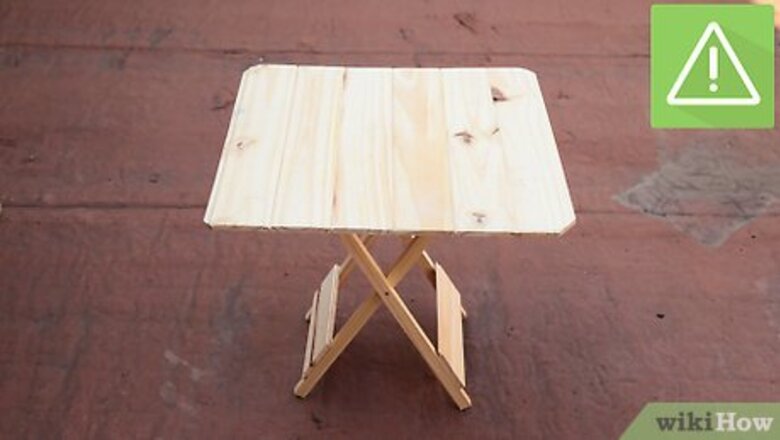
views
X
Expert Source
Andres MatheuCommercial Painter
Expert Interview. 28 July 2020.
After the primer is dry, paint the table in a well-ventilated area and let it dry between each coat. Once the paint has dried, finish with a protectant formula to seal in the paint job. Let that layer dry, and your table is ready to be used!
Prepping the Table
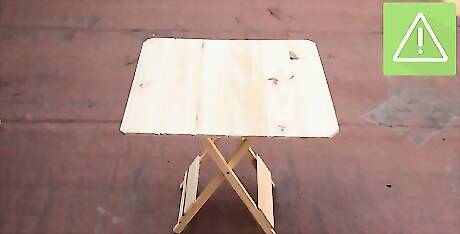
Separate any pieces that you don’t want stuck together. If your table has a leaf, pull it slightly open so the leaf doesn’t touch the edges of the main table. This way, the paint won’t seal the pieces together when it dries. If your table has no leaf, there’s no need to take pieces apart.
Sand down the tabletop to remove any thick varnish or imperfections. Use an orbital sander with some medium-grit sandpaper to sand the top of the table smooth. Go slowly and be careful not to gouge the surface. Don’t worry about removing all of the varnish, but sand down enough that the table isn’t too glossy and the primer will stick. If your table is unvarnished, use 150-grit sandpaper to sand the table’s surface smooth. Always remember to wear protective gear when sanding. Before you begin, put on gloves, eye protection, and a mask.
Wipe down the surface. Use a tack cloth to remove any dust, lint, and residue from the table, including the top and legs. All surfaces must be clean and dry in order for the primer to adhere.
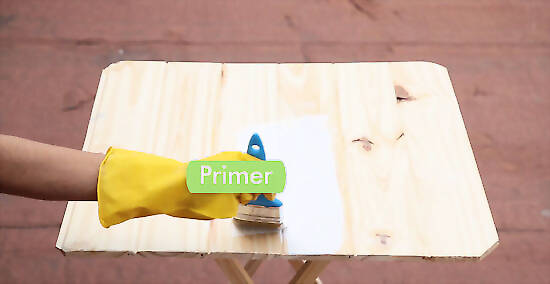
Prime the table with roll-on/brush-on primer. Roll-on/brush-on formulas are best for high-traffic surfaces like tables, since they tend to be thicker and more durable than spray-on formulas. Apply 1 coat of primer with a mini foam roller or medium to small brush. Let that layer dry before applying a second coat and letting it dry as well. Primer helps the paint stick to the wood and covers up any stains and discoloration. Make sure to roll or brush the primer in the direction of the wood grain. In between coats, wrap your roller or brush in a plastic bag and place it in the fridge. This will keep the paint moist and save you cleaning time in between layers.
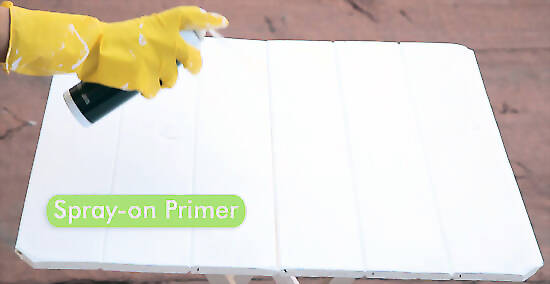
Use spray-on primer to fill in hard-to-reach crevices. If your table has lots of inset details or crevices that are difficult to paint over, use a spray-on formula to fill these areas in. This way, you’ll get an even base for the paint.
Sand the surface by hand. To finish preparing the table for painting, sand the primed surface smooth with fine-grit sandpaper. The orbital is too strong for the layer of primer, so sand gently by hand.
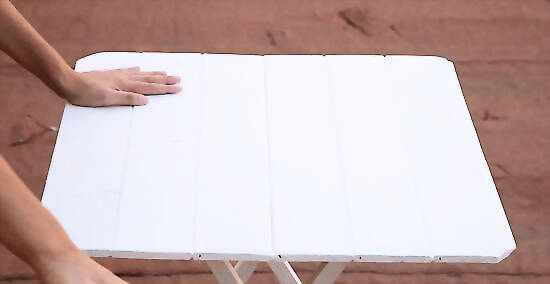
Wipe the table down with a tack cloth. Clean away any dust or debris from sanding. In order for the paint to properly adhere, make sure that the table is completely clean and dry before you begin painting.
Applying Paint
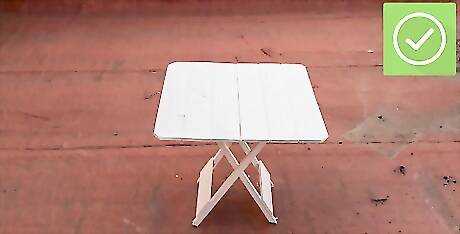
Find an open, well-ventilated area to paint. Choose an area with ventilation for paint fumes that won’t be in direct sunlight or affected by strong breezes. Make sure there’s enough room to walk around the table while painting. Generally, temperatures from 55 to 70 °F (13 to 21 °C) are best for painting.

Select either an enamel-, latex-, or oil-based paint. All 3 look beautiful and are easily washable. However, they vary when it comes to durability and user-friendliness. Enamel-based paints are known for being hard, durable, rust-resistant, and easily washable. Latex-based paints are also easy to clean and look beautiful, but they don’t cure as well and are nowhere near as durable. Oil-based paints have a strong, unpleasant smell and must be cleaned up with special solvents, but they sink into the wood as they cure, making them extremely durable and easily washable.
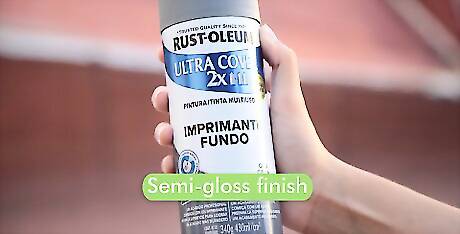
Choose a semi-gloss finish for high-traffic tables. Semi-gloss is best for kitchen tables because it’s tough, easy to clean, and hides fingerprints and smudges better than a flat-finish paint. If you choose a glossy finish, go for a semi-gloss indoor latex paint or a water-based enamel paint.

Choose a flat finish paint to cover up imperfections. Flat finishes work well for console tables or coffee tables because a smooth, matte finish hides any imperfections in the table’s textures. However, it is difficult to clean without damaging the paint job, so make sure not to use it on high-traffic surfaces. If you’re not sure if you want flat or semi-gloss finish, start with a flat-finish paint. If you later decide that you prefer gloss, you can cover the flat paint with a satin or semi-gloss finish.

Apply a thin, even layer of paint over the entire table. Use a brush to paint any crevices first. Next, use a 4 in (10 cm) foam roller to apply a thin layer of paint to the table's flat surfaces. The foam roller will create a smooth, even finish without any brushstrokes. Be careful to avoid drips around the table’s edges and try to make the transition between brush and roller as level and smooth as possible. Use a synthetic bristle brush with a latex-based paint, and a natural bristle brush for oil-based paint. Always paint in the direction of the natural wood grain.
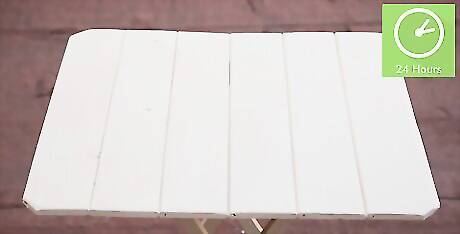
Let the paint dry for 24 hours. Waiting 24 hours will give the paint time to settle and adhere to the primed surface. Make sure the table dries in a shaded area so direct sunlight won’t affect the quality of the paint.
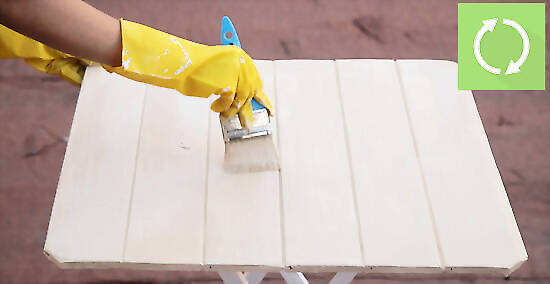
Apply 2-3 more thin coats of paint and sand each coat by hand. Let each layer dry for 24 hours, then lightly sand and wipe down the surface before applying the next layer of paint. With some fine-grit sandpaper, gently sand down any drips and imperfection to even out the paint’s level. The orbital can be too strong for the primer and paint, so sand by hand to smooth and protect each layer. Generally, 2-3 layers should be enough for lighter paints. Darker colors may need additional coats to get an even finish. Check for drips in areas where you switched between brush and roller.
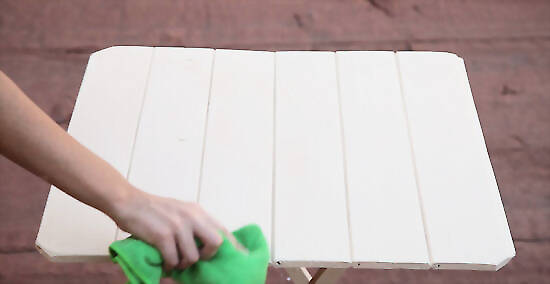
Wipe down the surface with a tack cloth. After sanding, always wipe away dust and debris with a tack cloth. This will help you achieve a smooth, professional finish.
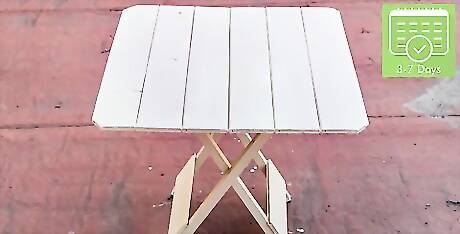
Let the paint cure for 3-7 days. Although the paint will feel dry to the touch in a day or 2, it actually needs 3-7 days to “cure,” or fully harden. This is especially important with oil- and enamel-based paints. If you don’t let the table cure long enough, it will be more prone to chipping and peeling. Avoid touching the surface and keep it in a dry, shaded space while it cures.
Finishing the Tabletop
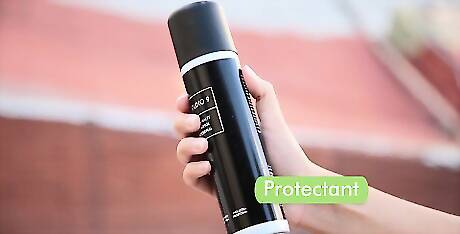
Decide if you want to apply protectant for more durability. If you want a final exterior layer of protection for your paint job, you can apply a finishing protectant to the tabletop. This is especially important for kitchen tables because it makes the surface easier to clean.

Use finishing wax for lighter paint colors. Because finishing wax won’t alter your paint’s color, it works great over light colors. To apply it, dip a clean cotton cloth into some clear paste wax and apply it evenly over the table’s surface. Let it dry for at least an hour, then buff away the excess with a clean cloth or electric polisher. Repeat the process 3-4 times until you’ve built up a tough exterior.
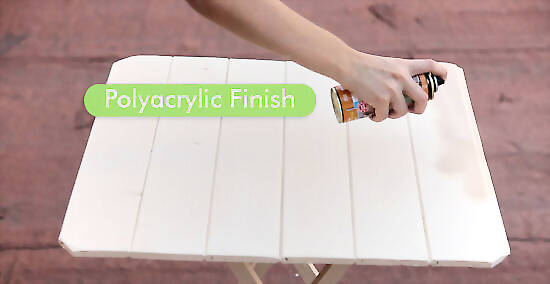
Pair a polyurethane or polyacrylic finish with darker paint colors. These protectants work well on darker colors that can hold up against the finish’s slight color alteration. To apply either finish, lightly sand the tabletop with 320-grit sandpaper and wipe away any dust. Use a foam roller to apply a thin layer of protectant. Let it dry for 2 hours. Repeat this process 3-4 times. Because these finishes tends to yellow over time, avoid using them over white or very light colors. When applying the protectant with a foam roller, make sure to go slowly to prevent bubbles from forming.

Let the finish cure for at least 48 hours. No matter which protectant you used, wait at least 2 full days before placing anything on the table. Disturbing the layers of while they’re curing could alter the topcoat’s strength, which is especially important on kitchen tables. You should also wait 1 week before using any cleaning products or chemicals on the table.




















Comments
0 comment